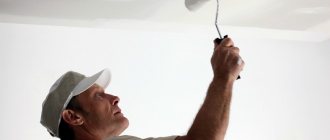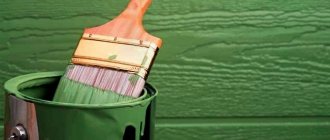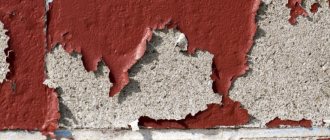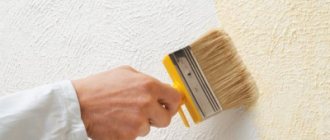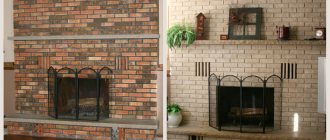If you know how to organize your work correctly, then achieving an ideal result is not difficult
Painting ceilings with acrylic paint is one of the most popular ceiling finishing options today. The composition fits perfectly on putty, plastered and plasterboard bases. But you need to choose high-quality paint and apply it according to technology to get an even color without streaks, streaks and other flaws.
In this article we will analyze all these issues so that you can carry out the work on your own.
Advantages of acrylic paints
It is customary to start renovation work indoors from the ceiling surface, since when painting it, there is a high probability that the paint may spoil the already pasted wallpaper or the finishing floor covering.
Acrylic-based paint compositions are the most popular. They have many positive properties, which is why they have taken a leading position in the modern building materials market.
Among the advantages it should be noted:
- Resistant to stains.
- The presence of such a quality as elasticity allows you to paint over small cracks, up to 0.5 millimeters. For this reason, the paint should be applied in several layers.
- This coloring composition is resistant to ultraviolet radiation and abrasion and therefore does not change its original color over time.
- Acrylic paints are not afraid of moisture - the repaired surface can be washed to remove dirt. They are also used to paint the ceiling in rooms with high humidity, namely in bathrooms and toilet rooms.
- Since acrylic-based compositions are resistant to friction and can withstand high temperatures, they are used in kitchen finishing.
- This type of coloring composition belongs to the water-based group and therefore does not have a strong unpleasant odor.
- Acrylic paints are easy to apply and dry quickly.
- The cost of this product is available to consumers.
- A wide color palette can please even the most demanding customers.
Roller selection
To paint the ceiling area you need a roller. The appearance, dimensions of the handle, and the diameter of the drum depend on the volume, as well as the complexity of the work. Main preferences:
- for a wide coverage area, a wide drum. Moreover, the wider it is, the longer its handle will be;
- the average diameter of the drum (15-18 cm) will allow you to perform work without fatigue, since it is not very heavy;
- It is important to paint a multi-level area with a small roller. A maneuverable attribute will allow you to efficiently solve a difficult problem.
Please note: Reasons for applying varnish to acrylic paint
Painting products with a removable short-pile coat are easy to use. They provide economical consumption of the coloring composition. But it is better to refuse foam structures.
Roller
Selection of acrylic-based paints
Currently, experts consider acrylic water-based paint to be the best, for the production of which acrylic resins are used. It is characterized by increased strength and elasticity.
Compositions made on the basis of acrylic copolymers are more affordable:
- styrene acrylic;
- acrylic silicone;
- vinyl acrylic.
Acrylic paint is available for sale in a wide selection of products that differ in consistency and composition. Some paints are intended for dry rooms, while others are intended for those where humidity is significantly increased.
Manufacturers do not recommend using the compositions for purposes other than their intended purpose, for example, if it is moisture-resistant, it is used to paint the ceiling surface in the bathroom. Acrylic paint for ceilings is usually sold in white, and the use of special colors helps to achieve the required shade.
Depending on the required degree of saturation, the required number of such tubes is added to the coloring composition. The retail chain also has paints in ready-made colors and shades.
Depending on the level of whiteness, acrylic compositions are:
- white;
- super white;
- milky white.
Before you paint the ceiling with acrylic paint, you need to purchase the whitest possible product. The label affixed to the bucket may contain information regarding a color that differs from the actual whiteness.
Therefore, it is advisable in the store to ask the seller to slightly open the lid in order to compare the color of the composition with a piece of white copy paper. If their whiteness is similar, then the paint can be used to paint the ceiling surface.
After complete drying, the ceiling with an acrylic surface has a glossy or matte texture. When choosing a coloring composition, you need to remember that in addition to the whiteness of the ceiling, dullness is considered another indicator of its impeccable appearance. The more it turns out, the less noticeable the defects of the ceiling surface, which include unevenness and uneven coloring, will be.
If you want to create a colored ceiling, it is better to use glossy compounds. But they can be chosen when the ceiling base is perfectly flat and has a significant area. Glossy paint is also purchased when the room is non-residential.
The highest quality among domestic and imported products is paint from the following companies: Svyatozar, Tikkurila, Dulux, Himaton, Himos and others.
Painting the ceiling with a spray gun
A spray bottle helps apply acrylic paints directly onto the primer or first coat of paint made with a roller.
To obtain the ideal layer, you must first dilute the paint to the density recommended by the instructions.
Apply the coating with a spray bottle using uniform, gentle movements, keeping an equal distance from the vacuum cleaner to the ceiling. The distance should not be more than 70 cm, but it is not recommended to bring the device closer. It does not need to be kept in one place for a long time so that the area does not stand out due to an excess of paint and to prevent the formation of smudges.
If you try, painting the ceiling with acrylic paint can be done not even by a professional, but by a person with minimal skills in construction and finishing work. Simple painting technologies will allow you to carry out the work at the proper level, not inferior to painters with extensive experience.
Preparing the surface for painting
Before painting the ceiling, floor and furnishings with acrylic paint, cover them with newspapers or plastic wrap so as not to stain them when preparing the ceiling for painting. Before doing this, you need to put on old clothes, a hat and rubber gloves.
Then they begin to clean the ceiling from dust and previous whitewash. To do this, a brush or roller is periodically moistened in clean warm water and passed over the entire surface of the ceiling. Work continues until the water in the container where the tools are placed stops becoming cloudy.
Particular attention should be paid to the junction of the ceiling and walls. The corners are washed with a brush. If the coating is semi-matte or glossy, then experts advise adding a little detergent to the water, and after rinsing, treat the surface with sandpaper.
If there are cracks and depressions in the ceiling, they are sealed. First, these places are opened with a spatula, cleaned and covered with putty. Next, the surface is primed to increase the degree of adhesion of the ceiling to the paint, to ensure the durability of the coating and as a preventive measure against the formation of fungus and mold.
The main thing is to select the putty and primer so that they are compatible. Since the ceiling is painted when it is level and smooth, the dried putty is sanded down with sandpaper to create a surface with a rough texture.
Before applying acrylic paint, if desired, perform intermediate decoration of the ceiling covering with previously prepared elements. Borders, baguettes and rosettes can be purchased in stores or you can make them yourself.
Mixing the coloring composition
You need to know how to dilute acrylic paint for the ceiling, since the final result depends on the correct preparation. The fact is that a thick coloring composition is not able to hide the junction of paint strips. The paint should be diluted with water until the consistency recommended by the manufacturer is obtained. Mix them together with a mixer.
When the instructions indicate adding water to the paint, its volume is usually no more than 5-10%. In some cases, it is not necessary to dilute the coloring composition, then the instructions simply indicate the need to mix it, but this should be done carefully.
If you plan to apply paint in one layer, then good mixing will be enough. The best option is considered to be diluting it to the consistency of milk. If there is a film on the surface, there is no need to mix it with the paint, since it does not dissolve after drying.
As a result of this action, the resulting composition ends up with lumps. Experts advise carefully removing the film, straining all the remaining substance and only then stirring. In addition, you can add antifungal components to the paint, which are highly resistant to wet cleaning.
Choosing the right tools for painting the ceiling
When choosing what to paint the ceiling surface with, you can choose a brush or roller. Each instrument has its own characteristics. It is better to use a brush if necessary to paint small areas. If the ceiling plane is significant, then a roller is used. The technology for applying paint with a brush and a roller is different.
If a brush is chosen as a tool, so that the paint does not flow down it while working, you can attach a foam roller to its handle, below the brush. It should be held perpendicular or at a slight angle relative to the surface to be painted.
When the brush is lowered into the paint, you must not allow the bristles to touch the bottom of the container, as it will become deformed. When taking it out, you need to knock on the edge of the jar. As a result, excess dye will be removed from the bristles, but you cannot wipe the tool on the container.
When working with a brush, make even strokes so that the stripes are wide, then they should be shaded. The handle is kept as close to the surface as possible, and as you move, the angle of inclination increases. When the smoothness of the surface matters, the strokes are applied by crossing them. In this case, two strokes are made on one area - one up and the other down.
While using the brush, it is periodically rotated around its axis to avoid uneven wear of the bristles. By taking breaks while painting, the tool is not allowed to dry out, otherwise it will become hard and unsuitable for further use.
When work with acrylic paint is completed, the brush is thoroughly washed so that not a drop of paint remains on it. Typically, white spirit or turpentine is used for this purpose.
Before you paint the ceiling with acrylic paint with a roller, you need to choose a tool taking into account the parameters of the ceiling surface. Its size must correspond to these values.
If you have to work with a roller, then the paint is first poured into a container. In a special bath, the composition should reach half. The instrument must be completely saturated when immersed. After dipping the roller in a container of paint, it is rolled over a non-working surface, which could be, for example, a piece of wallpaper or linoleum.
This technique allows you to evenly distribute the coloring composition over the surface of the instrument, resulting in a uniform coating. If you do not adhere to this rule, then “unpainted spots” appear on the ceiling, which form unsightly spots on an already dry surface.
The application of the coloring composition begins at a distance of about one meter from the corner. The start of work is to distribute a generous layer of paint over the ceiling surface. The roller should be moved away from you. When using this tool, the strokes should be placed crosswise relative to each other, as a result of which the paint layer will be distributed over the surface much more evenly and traces of painting will not be noticeable.
How to apply?
Painting a ceiling using old paint is not difficult; anyone, even an inexperienced person, can do it with their own hands. After all stages of preparation, you need to start painting.
The best paint coating is considered to be three layers; in this case, you can be sure that there will be no streaks or streaks left on the surface. Before applying each layer, the roller must be carefully rolled out in a tray to get rid of excess paint; thanks to such manipulations, the possibility of smudges is eliminated. The first and last layers should be applied correctly perpendicular to the windows; this applies to all types of paint, including acrylic.
The next layer should be applied only to a dry surface, and there is no need to speed up the process in any way; the paint should dry naturally.
After applying the second layer of paint, it is advisable to exclude the possibility of exposure to direct ultraviolet rays, as well as the occurrence of drafts, which will help to avoid peeling of the coloring material from the base.
You can paint the ceiling with several types of tools. The most common are a paint brush and a foam roller; you can also apply paint using a spray gun, which is a regular spray gun. This device helps to carry out the painting process much faster, the main thing is that the paint consistency is appropriate.
When repainting the ceiling, it is better to use the same color or a similar shade, otherwise you will have to apply a large number of layers to completely paint over the previous coating and achieve the desired result.


